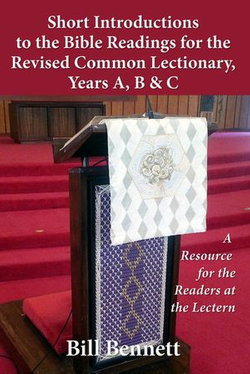Would you like a simple, quick way to engage with the RCL Old Testament, Epistle and Gospel readings for each Sunday and other important days in the church calendar?
Bill Bennett’s short introductions to each Bible reading will get you started.
There are several ways you can use this book:
- As a preface to the Bible reading in a service:
Before delivering each Bible reading from the lectern, read aloud the relevant short introduction given in this book.
The intention is to help congregation members to start to think their way into the meaning and significance of each Bible reading, as it is being read to them. The preacher will then usually expand on one or more of the Bible readings, given from the lectern, in their sermon or reflection.
As a courtesy, it is suggested that the person delivering the Bible readings check with the preacher that he or she is happy for the particular short introduction/s to be read. There may be times when the preacher wishes to emphasise a different interpretation of a reading and would prefer that the introduction not be given.
- As a sermon spark
It is hoped that preachers will find the short introductions give them an initial idea, or spark, to set them on the way to writing a sermon.
- For personal devotional reading
In the days leading up to the next service, you can read the short introductions and the relevant Bible passages as a personal devotion that will help you engage with the readings and sermon during worship.
If you can’t be at the service, treat the short introductions and Bible readings as your own time of worship.
- In your church’s weekly news bulletin
Churches are welcome to include the short introductions in their weekly, parish news bulletins. Please credit them as shown on the copyright page.
- Using the Scripture Index
The Scripture Index shows all the occasions on which a Bible reading occurs in this book. For ease of reference, the index is sorted alphabetically by the name of the book of the Bible, rather than the order in which the books appear in the Bible.
Notes on the contents of this book
- Psalms
This book does not include readings from the Psalms.
Some congregations include in their liturgy the Psalms set in the lectionary. Others use different Psalms that they think better fit with the theme/s of worship for the day. Also, congregations, if they sing or chant them, often repeat the same Psalm for 2-3 weeks so that people become acquainted with them. Some churches don’t use Psalms at all!
- New Zealand Anglican Lectionary — Te Maramataka
The readings in this book mainly follow the pattern of the Anglican Lectionary — Te Maramataka used in New Zealand.
Readers may find that are some regional, international or denominational variations in the readings set for the Revised Common Lectionary used by their local church.



Share This eBook: